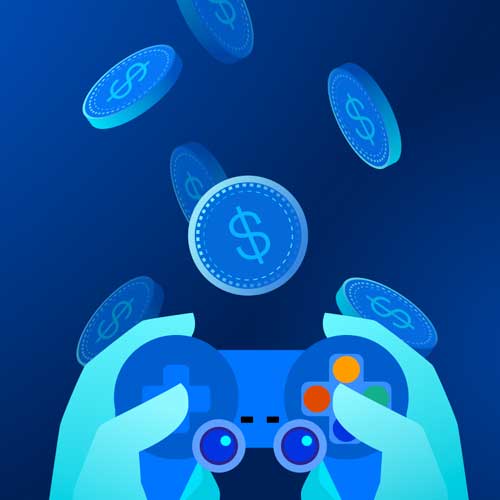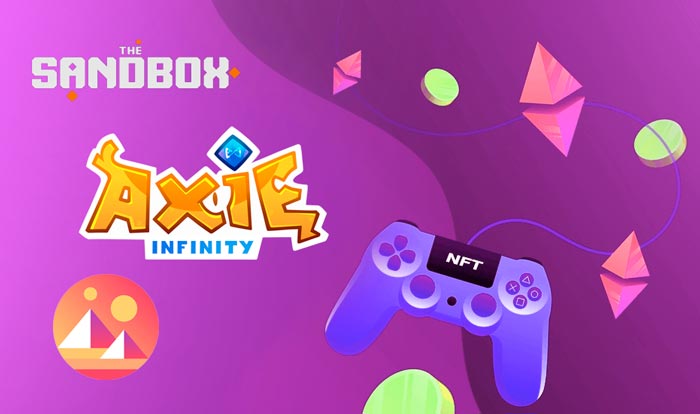What Are Play-to-Earn Games?
Simply put, play-to-earn games are video games where the player can receive rewards with real-world value.
Play-to-earn games (P2E) do what traditional video games don’t — reward players for their time and effort spent in the game. Each game offers a unique way for players to be rewarded for their in-game activity. This reward can be in the form of crypto, a non-fungible token (NFT), or an increase in value to a player’s existing NFT. Some P2E games will require an initial investment, while others are free to play.
What is cryptocurrency?
A cryptocurrency, crypto-currency, or crypto is a digital currency designed to work as a medium of exchange through a computer network that is not reliant on any central authority, such as a government or bank, to uphold or maintain it. It is a decentralized system for verifying that the parties to a transaction have the money they claim to have, eliminating the need for traditional intermediaries, such as banks, when funds are being transferred between two entities.
What is NFT and How Does NFT Work?
NFT means non-fungible tokens (NFTs), which are generally created using the same type of programming used for cryptocurrencies. In simple terms these cryptographic assets are based on blockchain technology. They cannot be exchanged or traded equivalently like other cryptographic assets.
Like Bitcoin or Ethereum. The term NFT clearly represents it can neither be replaced nor interchanged because it has unique properties. Physical currency and cryptocurrency are fungible, which means that they can be traded or exchanged for one another.
Now that you’ve taken your initial steps in understanding what an NFT is, you should continue on and learn about how an NFT works.
Also read: Popular Genres of Free Online Games
Is cryptocurrency safe?
Cryptocurrencies are usually built using blockchain technology. Blockchain describes the way transactions are recorded into “blocks” and time stamped. It’s a fairly complex, technical process, but the result is a digital ledger of cryptocurrency transactions that’s hard for hackers to tamper with.
In addition, transactions require a two-factor authentication process. For instance, you might be asked to enter a username and password to start a transaction. Then, you might have to enter an authentication code sent via text to your personal cell phone.
Defining Play-to-Earn Games

The term “play-to-earn games” gives you a good clue of what these games are.
Yes, players can really earn money by playing games.
Play-to-earn is a business model that works on blockchain technology. Put simply, players can play a game and potentially earn cryptocurrency.
How does all this happen exactly?
In play-to-earn games, players can get a hold of potentially valuable in-game assets. That can be anything — from skins or cards to a specific type of cryptocurrency. The more players play, the more assets they are able to collect, as well as make them more valuable.
In traditional games, these assets are only valuable inside the game in question. However, in play-to-earn games, they have real-world value.
At any moment, players can transfer these assets to the real world and sell them for cryptocurrency or real money on their own terms.
Moreover, unlike traditional games, these games are decentralized. This means that the developer isn’t able to control everything from its power center.
In play-to-earn games, in-game assets are distributed among players. By participating in the in-game economy, players generate value for other players as well as the developer.
All of this works for one simple reason.
These games consist of two things people crave — entertainment and the possibility of making money.
Also read: A Guide to Finding the Best Crypto Blogs for Guest Posting
Best Play-to-Earn Games with NFTs or Crypto
Play-to-earn gaming should start with research. Take some time to learn about the types of play-earn-games and which ones seem fun to you. You may want to start with a game that is free to play, just to get the hang of it.
You can earn crypto for playing anything from pet-centered games to 3D metaverse games and even fitness games, and it is up to you to decide what to do with your rewards. So, if you are curious to explore blockchain games that can earn you some extra cash.
- The Sandbox
- Axie Infinity
- Gods Unchained
- Splinterlands
- Pegaxy
- Aavegotchi
- Alien Worlds
- Arc8
- Axie Infinity
- Big Time
- Blankos Block Party
- Chainmonsters
- City States: Medieval
- Cometh
- Crazy Defense Heroes
- Crazy Kings
- Ethermon
- ev.io
- F1 Delta Time
- Galaxy Fight Club
- Gods Unchained
- Guild of Guardians
- Illuvium
- League of Kingdoms
- Lost Relics
- Meda WarsMegaCryptoPolis
- Mini Royale: Nations
- Neon District
- Nine Chronicles
- NFT Worlds
- Pegaxy
- Phantom Galaxies
- Planet Mojo
- REVV Racing
- Riot Racers
- Skyweaver
- Soccer Manager Elite
- Sorare
- Spider Tanks
- Splinterlands
- Summoners Arena
- Taurion
- The Sandbox
- Thetan Arena
- Town Star
- Upland
- Voxie Tactics
- Zed Run
What Is Axie Infinity?
Axie Infinity is a non-fungible token-based online video game developed by Vietnamese studio Sky Mavis, known for its in-game economy which uses Ethereum-based cryptocurrencies. Players of Axie Infinity collect and mint NFTs which represent axolotl-inspired digital pets known as Axies.
Axie Infinity is a monster-battling game where you pit teams of cute monsters called Axies against each other in battles.
Axie infinity gameplay can be summed up in a few simple steps.
- Buy Axies.
- Battle other players.
- Breed your creatures.
- Sell them in the marketplace.
But the Axie metaverse is rich enough that experiencing it offers more depth.
Axie Infinity : The Play-to-Earn NFT Game Taking Crypto by Storm
The game runs on the Ethereum blockchain with the help of Ronin, a sidechain that helps minimize fees and transaction delays. It’s primarily focused on turn-based battles, either against computer-controlled Axie teams or live opponents over the Internet.
In-game items are represented by NFTs, or non-fungible tokens. These cryptographically unique tokens can be linked to digital content—in Axie Infinity’s case, the Axies and land plots that populate the game. Unlike conventional in-game items, the NFT confers ownership on the buyer; you can trade Axies on the game’s marketplace for real money.
You can also breed Axies, which lets you build potentially more powerful teams and yields additional NFTs to sell on the marketplace. Some Axie NFTs have sold for as much as 300 ETH apiece, or more than $600,000 as of this writing.
How to get started with Axie Infinity
Here’s the hang-up: you will need three Axie NFTs to start playing Axie Infinity, and as of this writing, the most affordable Axies available on the marketplace are about $225-$250 apiece. You might spend $700 or more to build a starter team. That’s more than the price of a PlayStation 5 or Xbox Series X console, let alone a game. Keep in mind that your Axies are investments and can be resold, plus they generate rewards through gameplay.
What Is The Sandbox?
The Sandbox is a 2D sandbox game for mobile phones and Microsoft Windows, developed by the game studio Pixowl and released on May 15, 2012. It was released for PC on Steam on 29 June 2015.
A virtual world that’s driven by its community, The Sandbox allows creators to design, share and sell virtual world assets. The Sandbox is a gaming platform built on the Ethereum network, the leading blockchain platform for decentralized projects. The Sandbox metaverse attempts to change the dynamics of the gaming market by rewarding creators of user-generated content for the value they produce.
The Sandbox Crypto (SAND): Monetizing Virtual Gaming
Launched in 2011, The Sandbox is a virtual world where gamers can build, own and monetize their gaming experiences on the Ethereum blockchain. Pixowl co-founder/CEO Arthur Madrid and COO Sebastien Borget are the main driving forces behind The Sandbox, which is best known for its mobile games The Sandbox (2011) and The Sandbox Evolution (2016). To date, the games have racked up a total of over 40 million downloads on iOS and Android.
How You Can Earn Money in the Sandbox Metaverse?
The vast and immersive metaverse of the Sandbox is user-generated. This means that users can do anything they wish in the metaverse provided they have enough resources. For example, they can create their own labyrinths, games, and exhibitions, and can even host parties. This is also a huge advantage for developers who are looking to venture into the Web3 gaming segment. The Sandbox has already partnered with popular brands such as Adidas, Atari, The Smurfs, and even famous rapper Snoop Dogg. With this, the Sandbox has gained immense popularity both in terms of Play-to-Earn gaming and business.
How can you earn in the Sandbox?
To increase user involvement in the Sandbox metaverse, developers introduced two important tools – VoxEdit and Game Maker. Using these tools, users can create objects and experiences inside the metaverse and monetize these aspects.
What is Metaverse Cryptocurrency?
Metaverse cryptocurrency projects on blockchain networks are powered by fungible tokens – tokens that are divisible and can be mutually exchanged.
These tokens are used to purchase digital assets like virtual land or outfits for avatars. They can also be traded for other crypto or fiat currencies. Certain metaverse cryptocurrencies also allow their owners to vote on decisions within a metaverse platform such as where money should be invested or which new features to release first.
What is DECENTRALAND Metaverse?
Decentraland is a 3D virtual world browser-based platform. Users may buy virtual plots of land in the platform as NFTs via the MANA cryptocurrency, which uses the Ethereum blockchain. It was opened to the public in February 2020, and is overseen by the nonprofit Decentraland Foundation.
What if I tell you that Decentraland is nothing but a virtual real estate platform where you can buy or sell virtual plots called LANDs?
Decentraland is an Ethereum-based 3 Dimensional virtual platform, basically, a Metaverse where you can buy or sell lands/plots. Then, as per your requirement, you use the land to create your settings and apps or a marketplace. It thrives as the first-ever fully decentralized virtual space that allows people to immerse themselves in a unique experience of technology prowess.
As the name suggests, DECENTRALAND comprises two words, decentral and land. This means the platform is fully decentralized and is a perfect option for anyone with good knowledge of crypto and augmented reality willing to venture across the virtual world of Metaverse. The project was launched for public access in January 2020. It was led by Ari Meilich and Esteban Ordano.
It is an exclusive platform that allows users to create, trade, and monetize their digital content and virtual real estate properties. You can own anything and everything on Decentraland, starting from an art gallery to hangout spots, from conference centers to lavish homes. These virtual properties can be acquired as Non-Fungible Tokens using the MANA cryptocurrency. The basic tokens you can use in Decentraland are MANA, Estate, and LAND. Each of these tokens has a distinguished purpose in the Decentraland ecosystem.
A major portion of the Decentraland cluster is owned and managed by the Decentraland DAO. DAO or Decentralized Autonomous Organization uses an off-chain voting setup for the community. This gives the token holders a fair chance to cast their vote and get involved in governance decisions and proposals. The DAO owns the most crucial smart contracts that constitute Decentraland. This includes the LAND Contract, wearables, the Estates contract, MANA Metaverse tokens, and marketplace. The DAO makes the platform a suitable place for community growth and development.
What does the ‘decentra’ part of Decentraland mean?
When it comes to online browser-based games, you can say that RuneScape walked, so that games like Decentraland could fly. Unlike most other games operating under a virtual world framework, Decentraland is decentralized. Instead of having a single developer generate the game’s content, in-game content is created almost entirely by its community.
Notably, an analog to this format appeared more than a decade ago with the release of Spore in 2008. This life simulator allowed players to herd a species’ evolution from a cell-based organism into a space-faring civilization. Notably, other species encountered during gameplay were often species created by other players. You can imagine how that went down.
Decentraland players can create whatever they want to help populate the in-game world. And by whatever, we truly mean whatever. As of writing, Decentraland lacks any form of formal content moderation. Although this might seem like a red flag, other metaverse projects in the past have successfully launched without proper rules in place, instead relying on the community to “govern itself.”
The Benefit Of The Play-To-Earn Model
Traditionally, video games have been a one-way financial transaction.
You could buy a game through an online platform or buy a physical copy of the game. After installing it on your computer or gaming console, you’d have a license to play that game. The other popular option is ‘free-to-play,’ sometimes called ‘freemium,’ games. These are easily downloadable and cost nothing to play.
However, players are incentivized to speed up their game progress by purchasing assets within the game. In some cases, it’s considered nearly impossible to make progress in a freemium game without spending money—these are often called ‘pay-to-win’ games.
In both options, players spend money to play without getting anything in return.
The newcomer, play-to-earn, takes a different approach. Getting an initial start to the game isn’t always free. It’s not uncommon for games that offer NFT rewards to require a purchase of some in-game tokens before you can get started. But you own these tokens. They let you earn through playing without additional financial investment and can be resold later at your will. In other words, it’s possible to earn back the initial investment.
Conclution
Blockchain technology, such as cryptocurrencies and NFTs, are potential monetization routes for video games. Many live-service games offer in-game customization options, such as character skins or other in-game items, which the players can earn and trade with other players using in-game currency. Some games also allow for trading of virtual items using real-world currency, but this may be illegal in some countries where video games are seen as akin to gambling. This has led to gray market issues such as skin gambling, and so publishers typically have shied away from allowing players to earn real-world funds from games.
Blockchain games typically allow players to trade in-game items for cryptocurrency, which can then be exchanged for money, which may sidestep some problems associated with gray markets due to blockchain’s traceability.
Blockchain technology, which is used to power cryptocurrencies such as Bitcoin and Ethereum, is a ledger of transactions that is distributed across a network of computers. The decentralized model makes it difficult for people to alter the transaction information because the records must be the same across the whole network.
Typical gaming systems are centralized, so users can use their game earnings — such as XP or in-game currency — in only one game. However, blockchain games use a decentralized model so that users own their game data and can use it across other blockchain games.









